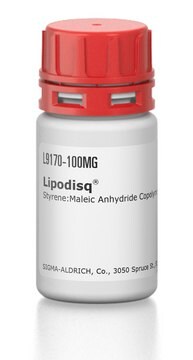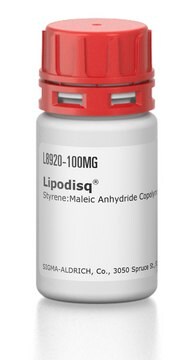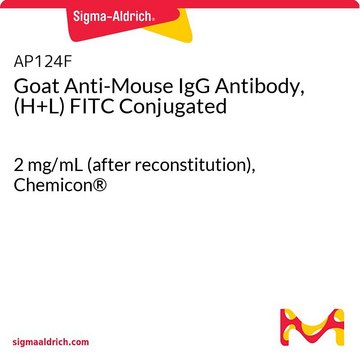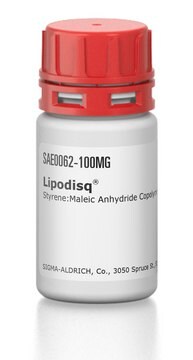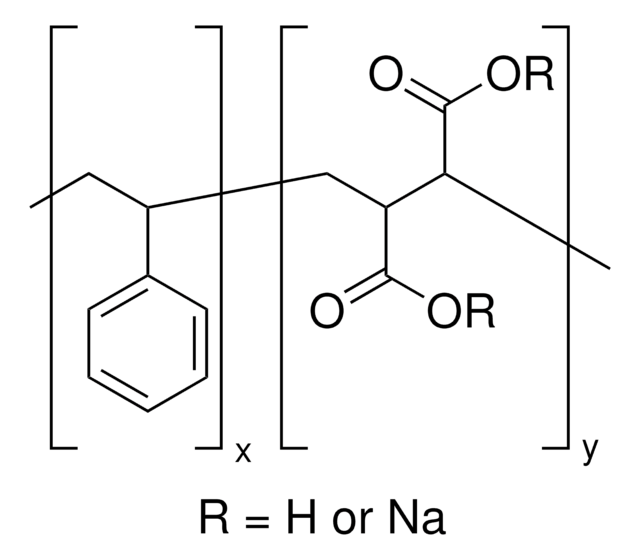Wszystkie zdjęcia(1)
Kluczowe dokumenty
L9045
Lipodisq®
Styrene:Maleic Anhydride Copolymer 3:1
Zaloguj sięWyświetlanie cen organizacyjnych i kontraktowych
About This Item
Kod UNSPSC:
12352202
NACRES:
NA.26
Polecane produkty
Szukasz podobnych produktów? Odwiedź Przewodnik dotyczący porównywania produktów
Opis ogólny
Lipodisq® reagents are novel polymers derived from styrene and maleic acid. Lipodisq® polymers are capable of forming nanosized lipid-based discoidal particles capable of incorporating membrane proteins. Lipodisqs typically have a diameter of 9-10 nm at pH 7.4.
Zastosowanie
Lipodisq® reagents are novel polymers derived from styrene and maleic acid. Lipodisq polymers are capable of forming nanosized lipid-based discoidal particles capable of incorporating membrane proteins. The Lipodisq technology can solubilize commonly used lipids such as dimyristoylphosphatidylcholine (DMPC) without the use of detergents. In general, Lipodisq polymers are potentially useful in mitigating the use of detergents for the solubilization of membrane proteins. Lipodisqs typically have a diameter of 9-10 nm at pH 7.4.
The Lipodisq technology can solubilize commonly used lipids such as dimyristoylphosphatidylcholine (DMPC) without the use of detergents.
Functional pH range: 6.0 - 9.0
Functional pH range: 6.0 - 9.0
Działania biochem./fizjol.
Lipodisq® polymers are potentially useful in mitigating the use of detergents for solubilization of membrane proteins. Dissolving this product in an aqueous solution, with sufficient base (e.g. KOH, NaOH), causes hydrolysis of each anhydride moiety into two carboxylic acid/carboxylate groups. This action renders the SMA polymer soluble in aqueous media. Lipodisq® acts as a potential membrane mimic system.
Informacje prawne
Lipodisq is a registered trademark of Malvern Cosmeceutics Limited
Ta strona może zawierać tekst przetłumaczony maszynowo.
produkt powiązany
Numer produktu
Opis
Cennik
Kod klasy składowania
11 - Combustible Solids
Klasa zagrożenia wodnego (WGK)
WGK 3
Temperatura zapłonu (°F)
Not applicable
Temperatura zapłonu (°C)
Not applicable
Wybierz jedną z najnowszych wersji:
Masz już ten produkt?
Dokumenty związane z niedawno zakupionymi produktami zostały zamieszczone w Bibliotece dokumentów.
Indra D Sahu et al.
Biochemistry, 52(35), 5967-5984 (2013-08-22)
Electron paramagnetic resonance (EPR) spectroscopy is a very powerful biophysical tool that can provide valuable structural and dynamic information about a wide variety of biological systems. The intent of this review is to provide a general overview for biochemists and
Juan F Bada Juarez et al.
Chemistry and physics of lipids, 222, 51-58 (2019-05-19)
Lipodisq™ nanoparticles have been used to extract surface lipids from the cuticle of two strains (wild type, N2 and the bacteria-resistant strain, agmo-1) of the C. elegans nematode without loss of viability. The extracted lipids were characterized by thin layer
Juan Francisco Bada Juarez et al.
Biochimica et biophysica acta. Biomembranes, 1862(3), 183152-183152 (2019-12-18)
Dopamine receptors (DRs) are class A G-Protein Coupled Receptors (GPCRs) prevalent in the central nervous system (CNS). These receptors mediate physiological functions ranging from voluntary movement and reward recognition to hormonal regulation and hypertension. Drugs targeting dopaminergic neurotransmission have been
Maria Lyngaas Torgersen et al.
Journal of biomedical nanotechnology, 16(4), 419-431 (2020-09-25)
Many promising pharmaceutically active compounds have low solubility in aqueous environments and their encapsulation into efficient drug delivery vehicles is crucial to increase their bioavailability. Lipodisq nanoparticles are approximately 10 nm in diameter and consist of a circular phospholipid bilayer
Juan Francisco Bada Juarez et al.
Chemistry and physics of lipids, 221, 167-175 (2019-04-04)
Nanoparticles assembled with poly(styrene-maleic acid) copolymers, identified in the literature as Lipodisq, SMALPs or Native Nanodisc, are routinely used as membrane mimetics to stabilise protein structures in their native conformation. To date, transmembrane proteins of varying complexity (up to 8
Nasz zespół naukowców ma doświadczenie we wszystkich obszarach badań, w tym w naukach przyrodniczych, materiałoznawstwie, syntezie chemicznej, chromatografii, analityce i wielu innych dziedzinach.
Skontaktuj się z zespołem ds. pomocy technicznej
